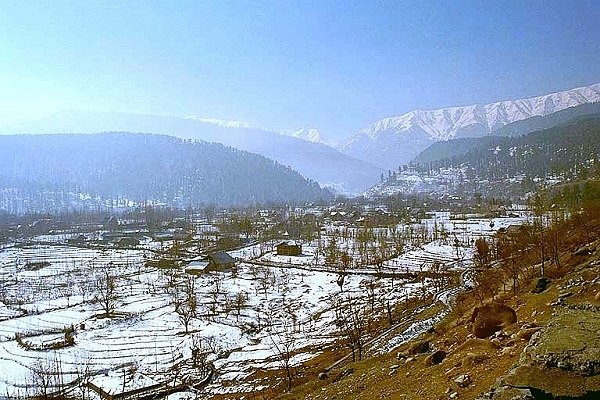
The Rich Literary Heritage Of Kashmir- Chandraka And Mentha
The aesthetic beauty of the classical compositions in Kashmiri literature may have origins in the poetic passages of the Vedas. We turn our attention to the first of the known classical poets of Kashmir.
इमं मे गङ्गे यमुने सरस्वति शुतुद्रि स्तोमं सचता परुष्ण्या। असिक्न्या मरुद्वृधे वितस्तयार्जीकीये शृणुह्या सुषोमया।। (ऋग्संहिता 8-3-6)
O river Ganga, Yamuna, Sarswati, Sutudri (Satadru or Sutlej) and Arjikiya (Yaskamuni identifies this as Vipasa or Beas), along with Parushni (Yaskamuni – Iravati or Ravi), Asikni (Chenab), Vitasta (Jhelum) and Sushoma (Yaskamuni – Sindhu), please heed my prayer.
A rishi prays to nine important rivers of India in the Rigveda, starting in the east with the Ganga and ending in the west with the Sindhu. Considering the several references to the rivers of Kashmir in the Vedic literature, especially to Vitasta, some of the Vedic hymns were likely composed on the banks of these rivers.
Perhaps, the aesthetic beauty of the classical compositions in Kashmiri literature have origins in the poetic passages of the Vedas. We turn our attention to the first of the known classical poets of Kashmir.
Chandraka
नाट्यं सर्वजनप्रेक्ष्यं यश्चक्रे स महाकविः। द्वैपायनमुनेरंशस्तत्काले चन्द्रकोभवत्।। राजतरङ्गिणी 2-16
Kalhana refers to the great dramatist Chandraka, as a Vyasa incarnate, in the Rajatarangini. Chandraka lived during the reign of Tunjina, who administered Kashmir with his queen, according to Kalhana. Kalhana says that the couple adorned Kashmir, the way the moon and Ganga adorn Siva. Based on Tunjina’s period, Chandraka lived in the 1st/2nd century CE. He is possibly the first of the renowned poets of Kashmir.
Though, Chandraka is known to have written a work called Natyaprabandha, unfortunately, none of his works are available. Quotes from his works by other poets provide a glimpse to the brilliance of the poet.
Dr. K S Nagarajan provides a simple verse, which Kshemandra quotes as Chandraka’s, in Auchityavicharacharcha –
युद्धेषु भाग्यचपलेषु न मे प्रतिज्ञा दैवं नियच्छति जयं च पराजयं च।
एषैव मे रणगतस्य सदा प्रतिज्ञा पश्यन्ति यन्न रिपवो जघनं हयानाम्।।
The divine disposes victory and defeat, so I make no vows in the face of fickle fortunes of a war. I always vow that no enemy shall see the rear of our horses, in war.
Perhaps a verse recited by a war-bound character in one of Chandraka’s dramas.
The poet effortlessly pays obeisance to Vyasa, echoing Krishna’s famed exhortation to Arjuna on duty and fruits of labour.
एकेनाक्ष्णा परिततरुषा वीक्षते व्योमसंस्थं भानोर्बिम्बं सजललुलितेनापरेणात्मकान्तम्।
अन्हश्छेदे दयितविरहाशङ्किनी चक्रवाकी द्वौ संकीर्णौ रचयति रसौ नर्तकीव प्रगल्भा।।
With an anger-filled eye fixed on the setting sun in the sky and the other tear-filled eye longingly looking at her lover, the female-chakravaka overcome by the hour of separation displays two complex emotions / ‘rasas’ (anger and sorrow) like an accomplished danseuse.
In this verse, Chandraka uses the classic Sanskrit illustration (called ‘kavisamaya’) of the pining of a Chakravaka bird for its lover during the night, when it apparently turns blind and has to wait for the sun-rise to be united again.
Chandraka delights the reader with his simple approach to and beautiful flow of the verses in classic metres like the Mandakranta or Vasantatilaka. One is left ruing the lack of availability of the works of a poet like Chandraka.
Mentha
बभूव वल्मीकिभवः पुरा कविः ततः प्रपेदे भुवि भर्तृमेण्ठताम्।
स्थितः पुनर्यो भवभूतिरेखया स वर्तते सम्प्रति राजशेखरः ।। बालरामायणं पञ्चमाङ्के 16
There once was poet Valmiki; post whom the world was blessed with Bhartru Mentha, who was followed by Bhavabhuti and now exists Rajashekhara.
Rajashekhara puts Mentha on the same pedestal as Valmiki and Bhavabhuti (and himself, of course). Mentha was considered a great enough poet to be prefixed with the honorific ‘Bharta’, one who rules. The name indicates that he was a mahout or an elephant hunter and was also called ‘Hastipaka’ for the same reason.
घासाग्रासं गृहाण त्यज गजकलभ प्रेमबन्धं करिण्याः पाशग्रन्थिव्रणानामभिमतमधुना देहि पङ्कानुलेपम्।
दूरीभूतास्तवैते शबरवरवधूविभ्रमोभ्रान्तरम्या रेवाकूलोपकण्ठद्रुमकुसुमरजोधूसरा विन्ध्यपदाः।।
Grab the grass bundle, forget the she-elephant’s love and apply the liniment of marsh to the wounds caused by the binding chains. Those Vindhyas, with kiratas frolicking about, with their greyish hue from the pollen of the flowers of the trees lining the Reva (Narmada) river, are now far off.
A beautiful verse of Mentha found in Srivara’s Subhashitavali (verse 605), provides some sense for the poet’s epithet. Mentha excelled in composing complex imagery in classical metres as the above verse illustrates.
Dr. Nagarajan states that Mentha was a student of Acharya Mukarbhakasankara of Kanchi and was later patronised by the king of Kashmir, Matrugupta, based on Mentha’s verse. This puts his time around 4th and 5th century CE. Students and scholars traveled the length and breadth of India, even in that time, in search of knowledge. Mentha is known to have composed a Mahakavya called Hayagrivavadha. Dr. Nagarajan alludes to tradition ascribing another work, Ramacharita, to Mentha.
Scholars I have met, agree with this view, based on Rajashekara’s verse, where the three known authors of works on the Ramayana are named with Mentha. Sadly, none of Mentha’s compositions are available, but for stray quotes by others. Blessed is the land of Kashmir, which gave us a mahout whose poetic genius is applauded in posterity as on par with Valmiki, Bhavabhuti, Bharavi and Bana.
References
- K S Nagarajan, “Contribution of Kashmiri to Sanskrit Literature”
You can read the first part of the series here